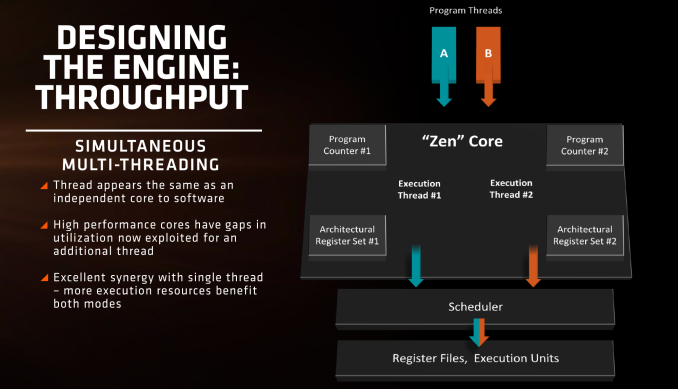AMD Zen Microarchitecture: Dual Schedulers, Micro-Op Cache and Memory Hierarchy Revealed
by Ian Cutress on August 18, 2016 9:00 AM ESTSimultaneous Multi-Threading
On Zen, each core will be able to support two threads in what is called ‘simulatenous multi-threading’. Intel has supported their version of SMT for a number of years, and other CPU manufacturers like IBM support up to 8 threads per core on their POWER8 platform designs. Building a core to be able to use multiple threads can be tough, as it requires a lot of resources to make sure that the threads do not block each other by consuming all the cache and buffers in play. But AMD will equip Zen with SMT which means we will see 8C/16T parts hitting the market.
Unlike Bulldozer, where having a shared FP unit between two threads was an issue for floating point performance, Zen’s design is more akin to Intel’s in that each thread will appear as an independent core and there is not that resource limitation that BD had. With sufficient resources, SMT will allow the core instructions per clock to improve, however it will be interesting to see what workloads will benefit and which ones will not.
Timeframe and Availability
At the presentation, it was given that Zen will be available in volume in 2017. As the AM4 platform will share a socket with Bristol Ridge, users are likely to see Bristol Ridge systems from AMD’s main OEM partners, like Dell and others, enter the market before separate Zen CPUs will hit the market for DIY builders. It’s a matter of principle that almost no consumer focused semiconductor company releases a product for the sale season, and Q1 features such events as CES, which gives a pretty clear indication of when we can expect to get our hands on one.
It’s worth noting that AMD said that as we get closer to launch, further details will come as well as deeper information about the design. It was also mentioned that the marketing strategy is also currently being determined, such that Zen may not actually be the retail product name for the line of processors (we already have Summit Ridge as the platform codename, but that could change for retail as well).
Wrap Up
AMD has gone much further into their core design than I expected this week. When we were told we had a briefing, and there were 200-odd press and analysts in the room, I was expecting to hear some high level puff about the brand and a reiteration of their commitment to the high end. To actually get some slides detailing parts of the microarchitecture, even at a basic cache level, was quite surprising and it somewhat means that AMD might have stolen the show with the news this week.
We’ve got another couple of pieces detailing some of the AMD internal/live benchmark numbers during the presentation, as well as the dual socket server platform, the 32-core Naples server CPU, and what we saw at the event in terms of motherboard design.











216 Comments
View All Comments
looncraz - Thursday, August 18, 2016 - link
Really, this design is like nothing Intel has.Intel uses a unified scheduler, and it looks from the diagram that AMD is using seven schedulers... which is just insane. Beyond both using SMT schemes and executing x86, they are very different designs.
e36Jeff - Thursday, August 18, 2016 - link
Just a quick FYI, Intel is licencing the SMT technology from Sun, as they hold the US patents for it. So Intel, just like AMD, is copying Sun.svan1971 - Thursday, August 18, 2016 - link
Wow that was a hell of a burn on AMD zingy....Nothing better than routing for Goliath huh.farmergann - Thursday, August 18, 2016 - link
Zen is actually an enlarged evolution of the Jag Cores with doubled up pipelines and SMT. Don't take my word for it either, study the link below and pay attention to what we learn about Zen. Jag/Puma+ are actually better Cores than their intel competitors despite a huge node disadvantage. AMD is back.http://www.realworldtech.com/jaguar/
msx68k - Thursday, August 18, 2016 - link
AMD did not copy anything from Intel, because Intel did not invent the SMT technique. The SMT was developed by IBM in '60, while CMT was by DEC in '90, and both are processor design techniques, something like Risc or CISC.The_Countess - Friday, August 19, 2016 - link
like intel copied the short pipeline of the athlon64, the on die memory controller, and the larger l1 and l2 caches, in addition to the already mentioned AMD64.medi03 - Friday, August 19, 2016 - link
That's one silly statement.That's the way progress works. When there is a good idea to (re-)use, you do it. Nothing wrong with it.
stimudent - Friday, August 19, 2016 - link
Think or research about what you're about to say before posting.SanX - Friday, August 19, 2016 - link
Doubt about that. Somebody is just pumping AMD stock. Typical bluff, none of these 200 journos have a clue about all these cache speed exchange etc, they understand only cash speed exchange. The 40% increase in processor performance they claim will actually be 20% or even 10%. And compared to Intel in 2017 - 0%. You can not jump factor of 2 anymore, the Moore's law is dead. And 10-20% difference in computing means EQUAL, and all that Zen noise means NOTHING.looncraz - Friday, August 19, 2016 - link
In order for the feat they demonstrated to be real, they had to have exceeded 40% IPC over Excavator, unless their SMT is scaling unusually well.FX-8350 at 3Ghz would take well more than twice as long. Even the FX-8350 at 4GHz would probably take twice as long.